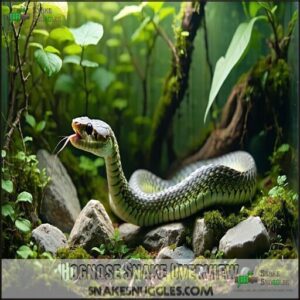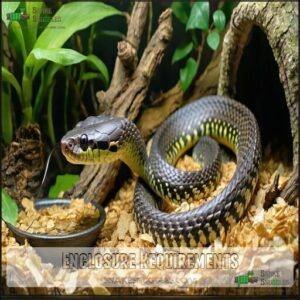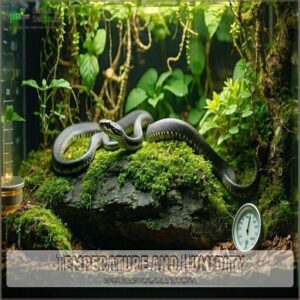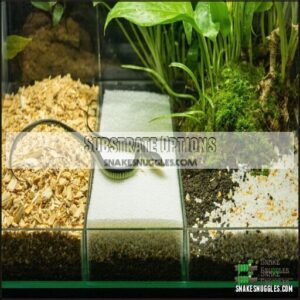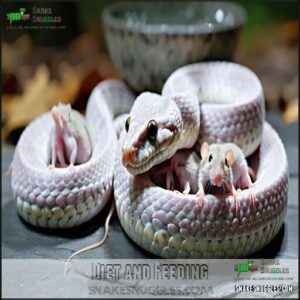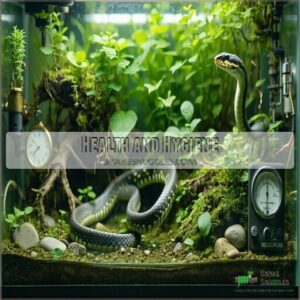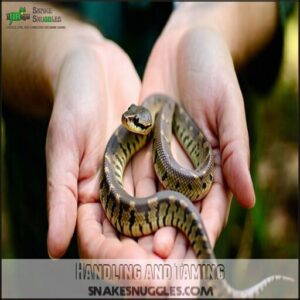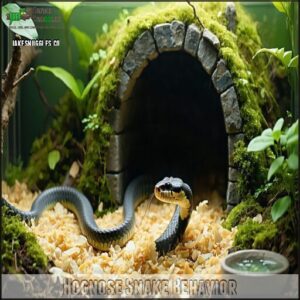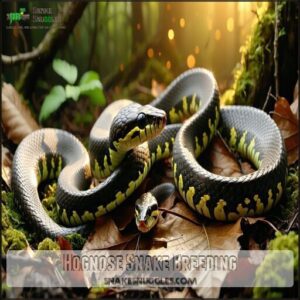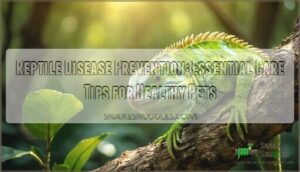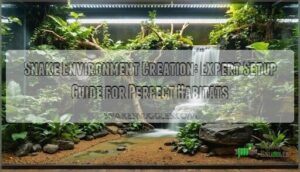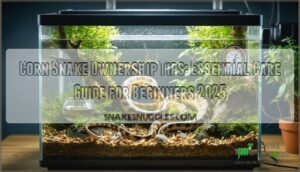This site is supported by our readers. We may earn a commission, at no cost to you, if you purchase through links.
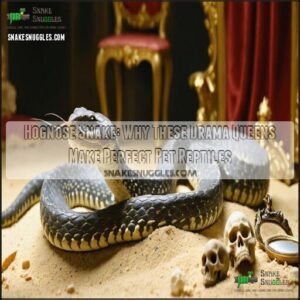 The hognose snake, often nicknamed the “drama queen” of reptiles, is a small, non-venomous snake known for its theatrical displays when frightened.
The hognose snake, often nicknamed the “drama queen” of reptiles, is a small, non-venomous snake known for its theatrical displays when frightened.
They’ll puff up, hiss, and even play dead—talk about over-the-top acting! With their adorable upturned snouts, these burrowers thrive in sandy or loose substrates, mimicking their natural habitats.
They typically grow 1.5 to 3 feet long and live up to 15 years in captivity. Known for their laid-back, curious nature, hognose snakes are a breeze to care for, provided you maintain proper temperatures and humidity.
Want to learn their quirks? Just wait until feeding time—it’s an entertaining experience! Hognose snakes are also notable for being easy to handle due to their curious nature.
Table Of Contents
- Key Takeaways
- Hognose Snake Overview
- Hognose Snake Habitat
- Hognose Snake Care
- Hognose Snake Behavior
- Hognose Snake Breeding
- Frequently Asked Questions (FAQs)
- Is a hognose snake a good pet?
- Are hognose snakes safe to handle?
- Do hognose snakes like to be handled?
- What is special about hognose snake?
- How does the hognose snake hunt?
- What is its natural habitat?
- Are they endangered?
- How long do they live in captivity?
- What is their diet?
- What are the natural predators of hognose snakes?
- Conclusion
Key Takeaways
- You’ll love how hognose snakes use their upturned snouts for burrowing and mimic cobras with their hissing and puffing defensive tricks.
- They thrive in sandy or loose substrates with a temperature gradient of 75-95°F and humidity levels of 30-50%.
- They’re easy to handle, low-maintenance, and can live up to 20 years with proper care in captivity.
- Their diet includes pinkies or mice, and they’re known for quirky eating habits like neutralizing toad toxins.
Hognose Snake Overview
You’ll find that hognose snakes, with their distinctive upturned snouts and theatrical defensive behaviors, make fascinating pets that rarely exceed 2-3 feet in length.
These nonvenomous drama queens from the Colubridae family can live up to 20 years in captivity and are known for their unique ability to play dead when threatened, earning them a special place in reptile enthusiasts’ hearts.
Species Classification
In the context of hognose snake classification, you’ll find these drama queens divided into three distinct genera: Heterodon, Leioheterodon, and Lystrophis.
The Heterodon genus includes the most popular pet varieties—Eastern, Western, Southern, Mexican, and Dusty hognose snakes.
Leioheterodon features the Malagasy species, while Lystrophis encompasses the South American varieties.
With 14 total snake species across these genera, each offers unique characteristics for enthusiastic reptile keepers, making them complete concepts for study.
Physical Attributes
You’ll immediately identify a hognose snake by its distinctive upturned snout morphology, perfect for burrowing.
These stocky reptiles showcase rough, keeled scales and display remarkable color variations with over 60 morphs available.
Western hognose species typically feature brown blotchy patterns, while sexual dimorphism is evident—females grow larger (20-35 inches) than males.
Their broad head and thick body make them instantly recognizable among pet snakes.
Lifespan and Size
Beyond their distinctive snouts, hognose snakes offer a manageable average lifespan of 8-10 years in captivity, with some reaching 20 years with proper care.
Size variation is notable between species: females typically grow larger than males. Adult female length averages 20-35 inches with weights of 250-400 grams, while adult male length stays around 15-25 inches with weights of 100-250 grams.
Growth rate slows after their first two years.
Hognose Snake Habitat
You’ll need to recreate your hognose snake’s natural habitat with sandy soil substrates and proper temperature gradients from 75-95°F to keep these burrowing enthusiasts healthy.
In the wild, these distinctive reptiles thrive in North America’s prairies and flat, scrubby areas where they can dig and hunt using their specialized upturned snouts.
Enclosure Requirements
A good hognose habitat starts with the right snake enclosure. Use a 20-gallon tank with a secure lid to prevent escapes.
Include decor enrichment like rocks and hides for stimulation. Verify that your enclosure setup has ample floor space and a temperature gradient for comfort.
You can find a hognose snake enclosure online. UVB lighting isn’t required but mimics sunlight and enhances your snake’s environment naturally.
Temperature and Humidity
Keeping your hognose snake happy starts with the right temperature and humidity.
Set up a basking spot at 85-90°F while maintaining a cool side around 70°F for a proper temperature gradient.
Snake humidity levels should range between 30-50%.
Use a thermostat for control and adjust seasonally.
Regularly monitor with hygrometers—your hognose appreciates a cozy, well-balanced climate!
Providing at least 4 inches of substrate is also essential for their well-being.
Substrate Options
Choosing the right snake substrate is key to your hognose’s happiness.
Aspen shavings work well for burrowing, while soil mixtures or bioactive substrates mimic natural habitats.
Avoid sand due to ingestion risks.
Consider humidity retention based on your snake enclosure setup.
You can purchase hognose substrate online for convenience.
Match snake enclosure size to your chosen substrate, ensuring enough depth for digging—their favorite “sport”!
Hognose Snake Care
Taking care of a hognose snake is straightforward if you understand their specific needs.
By providing the right diet, clean enclosure, and proper handling, you’ll keep your snake healthy and stress-free.
Diet and Feeding
Hognose snakes are hearty eaters with quirky dining habits. Their diet includes thawed, appropriately-sized prey, matching their body width.
Watch their feeding frequency—young hatchlings eat more often, while adults enjoy weekly meals. Struggling? Try scenting techniques like toad consumption to tempt picky eaters.
Many owners purchase snake food products online for convenience. Meeting their nutritional needs is simple; just tailor the snake diet to suit your hognose morph’s size and appetite.
- Feed appropriately-sized prey once weekly.
- Use scenting techniques for reluctant feeders.
- Adjust feeding frequency as snakes grow.
Health and Hygiene
A hognose snake’s health depends on maintaining its enclosure. Watch for respiratory infections or shedding problems—signs of snake diseases like fungal infections or mouth rot.
Prevent mites by cleaning regularly. Spot-clean daily, deep-clean monthly. Always provide the right humidity and temperature for reptile health.
To encourage natural behaviors, consider environmental enrichment options within the enclosure. Here’s a table to help:
| Issue | Symptom | Prevention | Treatment | Frequency |
|---|---|---|---|---|
| Respiratory Infection | Wheezing | Humidity balance | Vet care | Monthly |
| Mouth Rot | Swelling, bubbles | Good hygiene | Antibiotics | Bi-weekly |
| Fungal Infections | Discoloration | Proper humidity | Antifungal meds | Monthly |
| Shedding Problems | Retained skin | Provide moisture hides | Soaks, humidity | Every shed |
| Mites | Visible bugs | Spot cleaning daily | Medicated sprays | Weekly |
Handling and Taming
Building trust with your hognose starts with safe handling and taming techniques.
Their docile nature shines when stress is minimized through slow, gentle movements. Avoid sudden grabs—these drama queens rely on defensive behavior to bluff.
Regular handling reduces their shyness, improves temperament training, and prevents bites. Be patient; trustbuilding takes time, but you’ll both enjoy the snake handling experience!
Hognose Snake Behavior
Hognose snakes are famous for their theatrical defensive behaviors, from hissing and puffing up to flipping over and playing dead.
You’ll also notice their curious nature as they burrow and explore, making them both entertaining and fascinating pets.
Defensive Mechanisms
It’s hard not to laugh at their theatrics.
When threatened, hognose snakes put on an award-worthy performance with their defensive behavior:
- Playing Dead: They roll over, tongue out, looking like a reptile Oscar nominee.
- Hissing Display: Loud, dramatic hissing paired with intimidating Head Flattening mimics cobras.
- Foul Odor: They even release skunk-like musk for extra flair!
Some hognoses are selectively bred for color, resulting in various snake morphs.
Social Interaction
While their playing dead antics steal the show, hognose sociability extends to human interaction too.
These snakes have individual personalities and a calm snake temperament once familiar with handling.
Unlike some reptiles, they rarely stress around gentle humans.
Cohabitation success isn’t guaranteed though—stick to solo habitats to avoid potential issues with their defensive behaviors or unpredictable snake behavior.
Burrowing and Exploration
These snakes love using their upturned snout to burrow through soft substrates like aspen shavings or soil.
Offering substrate options catering to their burrowing instincts keeps them active and happy.
Hiding spots and enclosure enrichment mimic natural behaviors, encouraging exploration.
Watching them reshuffle their snake habitat is both entertaining and a sign they’re thriving, as burrowing strengthens curiosity and exploration benefits overall health.
Hognose Snake Breeding
If you’re considering breeding hognose snakes, you’ll need to prepare for their unique mating behaviors and habitat needs.
These snakes require careful temperature control and brumation to reproduce successfully.
Mating and Reproduction
Snake breeding requires patience.
Hognose snakes benefit from a 12-week brumation period before mating.
Females lay eggs 7-9 weeks post-mating, with clutch sizes ranging from 2-30 eggs.
Their reproductive quirks include sperm storage for ideal egg laying.
Successful snake reproduction depends on healthy pairings, good timing, and ensuring your snakes are well-fed and thriving before mating attempts.
Egg Incubation
After egg laying, guarantee proper incubation temperature and humidity levels for hatching success.
Maintain 80-85°F and 75-90% humidity. Use an incubation medium like vermiculite or perlite to keep eggs stable.
Proper temperature control is essential for ideal breeding conditions. Hognose eggs typically need 6-8 weeks of incubation time.
Monitor conditions regularly; small shifts can affect outcomes. When done right, you’ll soon meet your wiggly new hatchlings!
Hatchling Care and Feeding
Once your hatchlings emerge from their eggs, focus on proper snake feeding routines.
Start with small frozen-thawed pinkies matching their hatchling length and weight. Feed every 4-5 days after the first shed.
Stubborn eaters? Scenting techniques like rubbing prey with tuna help. Avoid handling after meals.
Gradually adjust the feeding schedule and size for healthy growth and brumation prep.
Frequently Asked Questions (FAQs)
Is a hognose snake a good pet?
A hognose snake can make a great pet if you enjoy quirky behavior and low maintenance.
They’re docile, easy to handle, and amusing with their dramatic “playing dead” act.
Just guarantee proper care and habitat!
Are hognose snakes safe to handle?
Imagine handling a feisty noodle with a flair for drama.
Hognose snakes are mostly harmless and rarely bite, relying on bluffing tactics.
Consistent, gentle handling guarantees they stay calm, making them safe, quirky companions.
Do hognose snakes like to be handled?
They’re generally tolerant of handling, especially if raised around people.
Regular, gentle interactions help them stay calm.
Just don’t mistake their bluffing for aggression—they play tough, but they’re harmless and secretly love the attention!
What is special about hognose snake?
It’s like nature gave them a theatrical flair—hognose snakes dramatically play dead, hiss, and puff up like tiny cobras when threatened.
Their upturned snout, perfect for burrowing, and harmless “venom” make them uniquely enchanting.
How does the hognose snake hunt?
You’ll find them using their upturned snout to dig for buried prey, mainly toads.
They strike quickly, use rear fangs to subdue, and even neutralize toxins from toad skin—a clever dining trick, right?
What is its natural habitat?
Picture a snake vacationing in sandy prairies or flat scrublands.
That’s the hognose snake’s natural habitat.
They love dry areas, stretching from Canada to Mexico, where burrows and loose soil suit their digging lifestyle perfectly.
Are they endangered?
Hognose snakes aren’t endangered, but their populations face threats from habitat loss and misconceptions.
People sometimes mistake them for venomous snakes and harm them unnecessarily.
Protecting their habitats and spreading awareness helps guarantee their survival.
How long do they live in captivity?
They stick around for the long haul in captivity, living 8 to 10 years on average.
With proper care—think cozy setups and healthy meals—they might even surprise you by reaching 20 years!
What is their diet?
Their diet includes toads and mice, with young snakes eating pinkies or crickets.
They’ve got a knack for neutralizing toad toxins.
Feed hatchlings every 5-6 days and adults once weekly—no live prey needed!
What are the natural predators of hognose snakes?
In the wild, they’re up against birds of prey, raccoons, and foxes.
Sometimes even other snakes target them.
Their dramatic defensive antics—hissing, striking, or playing dead—are like theater to confuse these predators and escape unharmed, with actions that include striking.
Conclusion
Caring for a hognose snake is like hosting a tiny, scaly entertainer.
From its theatrical defense displays to its curious, burrowing behavior, this snake keeps you intrigued while being relatively low-maintenance.
With proper care—like maintaining the right temperature, humidity, and a sandy substrate—these non-venomous, mellow reptiles thrive.
Their quirky feeding habits and manageable size make them ideal for beginners and experienced keepers alike.
A hognose snake isn’t just a pet—it’s a charming, show-stopping companion that provides proper care and is a tiny entertainer.

